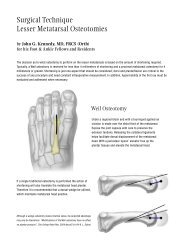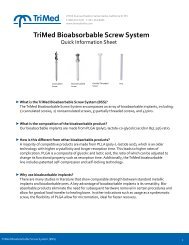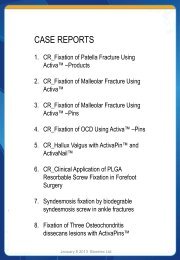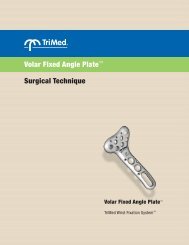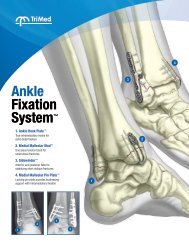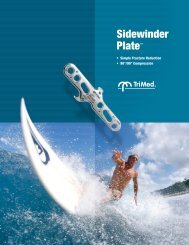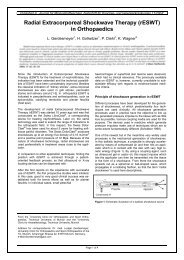Swiss DolorClast ® Brochure - Ortho Providers
Swiss DolorClast ® Brochure - Ortho Providers
Swiss DolorClast ® Brochure - Ortho Providers
You also want an ePaper? Increase the reach of your titles
YUMPU automatically turns print PDFs into web optimized ePapers that Google loves.
Heel pain is a “catch-all term” for any condition that can occur around the heel. The most common<br />
of these conditions is known as PLANTAR FASCIITIS. The plantar fascia (PF) is a strong ligament (tensile<br />
strength of 4000 lbs/sq. inch) that is located along the under surface of the foot, extending from the base of<br />
the toes to the heel bone (calcaneus). The PF is almost as wide as the foot and plays an important role in<br />
support of the foot as well as function.<br />
> When the plantar fascia is strained due to overuse, improper shoes, or abnormal foot structure, it can<br />
initially become irritated and painful. As we get older, tissues become less flexible and the PF can become<br />
strained from something as simple as walking a full day in Disneyworld with non supporting, flat shoes.<br />
Although most people have heel pain that lasts only a couple of days, many have repeated episodes of PF<br />
strain leading to the development of scar tissue in the plantar fascia. It is thought that this scar tissue is the<br />
cause of chronic heel pain also known as plantar fasciosis. Although heel spurs (a small forward projection<br />
of bone under the heel) are related to plantar fasciitis, research has shown that permanent elimination of<br />
heel pain caused by plantar fascioses does NOT require the removal of the heel spur.<br />
> Plantar fasciitis is diagnosed with the classic symptoms of pain well localized over the heel area of the<br />
bottom of the foot. Often the pain from plantar fasciitis is most severe when you first stand on your feet in<br />
the morning. Pain often subsides quite quickly, but then returns after prolonged standing or walking.<br />
<br />
> Plantar fasciitis is most often seen in middle-aged men and women, but can be found in all age<br />
groups. The condition can be seen in people with high arches, normal arches, and flatfeet. Activities that<br />
seem to initiate PF are people who change their heel height on shoes from normal to flat heels; walking or<br />
running on a soft surface with non supporting shoes; taking on an exercise program and doing too much,<br />
too fast, and standing for long periods of time on a hard surface.<br />
> Plantar fasciitis is sometimes, but not always, associated with overweight people. It is sometimes seen<br />
in recreational athletes, especially runners. In these athletes, it is thought that the repetitive nature of the<br />
sport causes damage to the tissue at the attachment of the PF to the heel.<br />
> Symptoms of plantar fasciitis are typically worsened early in the morning after sleep. At that time, the<br />
arch tissue is tight and simple movements stretch the contracted tissue. As you begin to loosen the foot, the<br />
pain usually subsides, but often returns with prolonged standing or walking.



